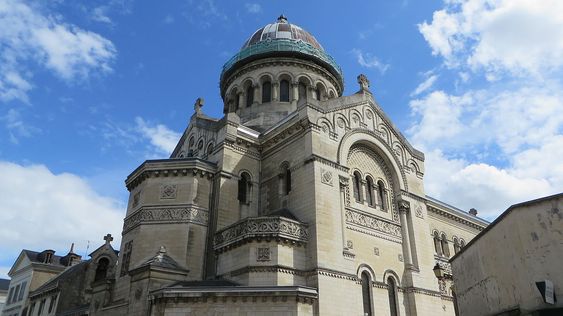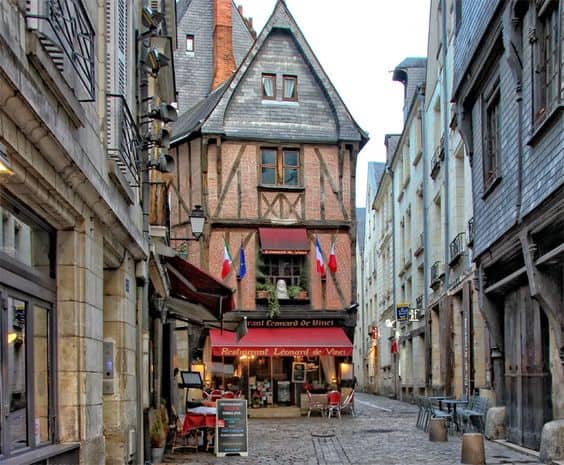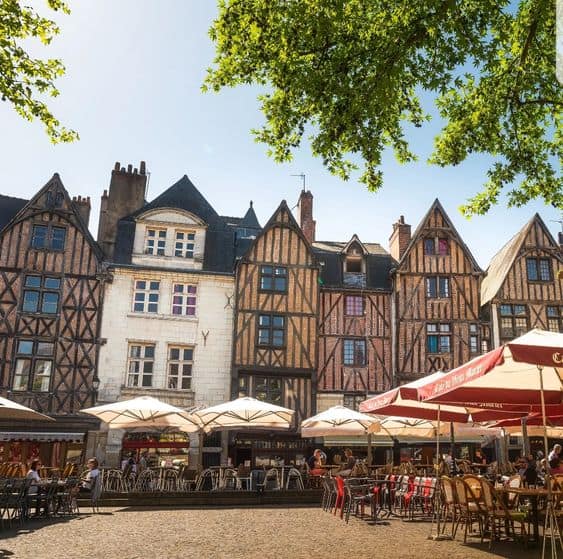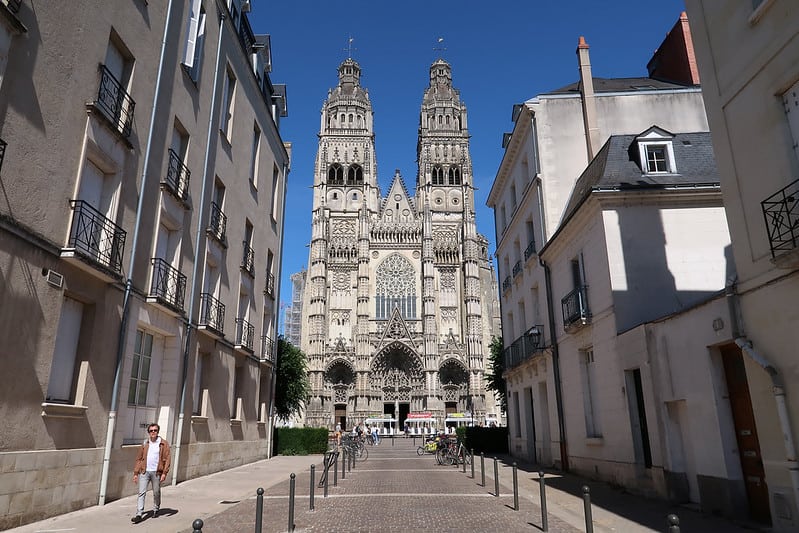Tours is a historic university town situated between the Cher and Loire rivers. This ancient settlement dates back to the Gallic and Roman times and is a traditional gateway to the Loire Valley. Tours has many significant landmarks, including the cathedral, which features a Gothic facade and Renaissance-styled towers.
Cathédrale Saint-Gatien
The Cathédrale Saint-Gatian in Tours France is a Roman Catholic cathedral. It is dedicated to Saint Gatianus and is the seat of the Archbishops of Tours and the metropolitan cathedral of the ecclesiastical province of Tours. The cathedral was built between 1170 and 1547.
The Cathédrale Saint-Gatian is a spectacular Gothic cathedral that was built in the thirteenth and fourteenth centuries. It features medieval stained glass windows and a soaring, majestic interior. The cathedral is a huge structure that is often crowded. It features a large rose window that is in the shape of a semicircle and contains more than a hundred bible stories depicted on its walls.
The cathedral is also home to an organ donated by Archbishop Martin de Beaune and built by Barnabe Delanoue in the sixteenth century. It contains a tomb that contains the infants of Charles VIII and Anne of Brittany. Its marble coffins were designed by Michel Colombe, the city’s most famous sculptor at the time.
Musee du Compagnonnage
The former abbey is now home to the Crafts Museum. The exhibitions feature the history of trade-guild crafts. You can see intricate crafts and learn about the trade guilds. This museum is a must-see if you’re in Tours.
The museum’s small size belies its rich history. The exhibitions showcase the work of dozens of skilled craftsmen. Items on display here range from miniature wrought-iron gates to wooden architectural models. Whether you’re interested in a traditional craft or a more contemporary one, you’ll be inspired by this unique museum in Tours, France.
The museum opened in 1968 and is now part of the city’s cultural heritage. The museum is located in the former dorms of the Benedectine Abbey of Saint Julien. Inside, you’ll find the collections of a number of master craftsmen, which date back to the Middle Ages. The compagnonnage museum’s exhibits are so important to the country’s culture, that they’ve been registered as intangible cultural heritage by UNESCO.
The Musee du Compagnonnage is a fascinating museum in Tours, France, located in an old abbey. Here, you can see the works of art of these famous Compagnons, as well as their tools and archives. The museum is open to the public and offers themed tours in English. The museum also provides activities for children to enjoy.

Basilique Saint Martin
Visit the Basilique Saint Martin in Tours France, a Roman Catholic basilica dedicated to Saint Martin of Tours. The basilica was built over the tomb of the Saint. It is a popular tourist attraction for those traveling to Tours. The basilica is located at the top of a hill overlooking the city. The Basilica is free to enter. It is a beautiful place to spend an afternoon.
You can also visit the Basilique Saint Martin Museum, located adjacent to the basilica. Inside, you’ll find an enchanting display of the basilica’s history. You’ll also find a replica of Saint Martin’s tomb. The basilica is also near the Opera de Tours, the Museum of Fine Arts, and the Museum of Companionship.
The Basilique Saint Martin in Tours is a beautiful example of neo-Byzantine architecture. It has a large painted dome over the transept and features rows of polished granite columns. It is an important place of worship and contains the tomb of Saint Martin.

Jardin Botanique de Tours
If you are fond of plants and gardening, then the Jardin Botanique de Tours should be a must-see. Opened in 2003, the garden has the missions of conservation, research, and education. Besides plants, it has a wide range of animals, too. There are tortoises, anes, chevres, canards, and perroquets to admire.
This garden is open to the public and has many activities throughout the year. It covers 6 hectares and is divided into several gardens. Visitors can wander through the gardens and learn about the properties of plants. They can also visit the Orangerie and the Serres d’Oe, which are open daily.
If you are travelling by public transport, you can use Moovit to get to the Jardin Botanique in Tours, France. The app will provide you with live directions and free maps. It will also help you find the best times to take the bus or train to reach the Garden.
Musée des Beaux-Arts Tours
If you want to get a good dose of Beaux-Arts, visit the Musée des Beaux-Arts de Tours, which is housed in a former bishop’s palace. The museo has been open since 1910 and offers an array of collections to explore. One of its highlights is its collection of paintings, which is one of the oldest in France.
The museum features a large collection of neoclassical and impressionist paintings. In addition, you’ll find a collection of paintings from the Age of Enlightenment. There are also several works from leading impressionists. And there’s even a large garden on the grounds!
The Musée des Beaux-Arts de Tours is located in the heart of the city. The museum’s collection includes works by Rubens, Rembrandt, Rodin, Monet, and Degas. It also features a courtyard that is dominated by a magnificent cedar of Lebanon. There’s even a stuffed elephant called Fritz in the courtyard, which was killed in a Barnum and Bailey circus parade in Tours. The museum also has a cafe, Aux Delices des Beaux-Arts.
Jardins des Prébendes d’Oé
In the heart of Tours, France lies the Jardins des Prébendes d ‘Oe. This park is a designated cultural site and was designed by the Buhler brothers. Located between Boisdenier Street and Lakanal Street, this park is an ideal place to take a stroll. The park is also home to several statues of famous artists from Tours.
The Prebendes d’Oe garden has many different types of flowers and trees. You can even find some statues of writers, children’s games and a gazebo for concerts. The garden was designed by the Buhler brothers between 1872 and 1874. You can stroll through the garden on the many winding paths and enjoy the beautiful scenery.
In 1851, the city of Tours was still densely populated, so the mayor, Jean Royer, decided to make it more open to the public. The goal was to improve the quality of life for residents. The city began offering tours of its rivers and lakes to tourists and residents.
Place Plumereau
The central square of Tours, France, Place Plumereau, is a popular meeting place for tourists and students. Located on the banks of the Loire River, it’s easily accessible from most parts of town. Place Plumereau is surrounded by half-timbered houses and has a lively atmosphere.
Place Plumereau is a pedestrian plaza surrounded by 15th-century half-timbered houses. This lively square is a favorite of photographers because of its beautiful architecture and festive ambiance. It is also one of the busiest places in Tours, so there’s always something happening.
Located in the historic district of Tours, Place Plumereau is a beautiful spot for an aperitif. It was recently recognised by Lonely Planet as France’s best aperitif square. Moreover, it is just 10 minutes from your hotel.
Another attraction in Tours is the Cathedral of Saint-Gatien. Founded in the 6th century, this church is the largest in the city. It is a prime location for tourists, since it’s close to the main chateaux of the Loire Valley. It has great public transport connections and a train station. A half-day visit to the city will give you a chance to explore the historic center and take in the half-timbered houses, as well as the impressive Saint-Gatien Cathedral. The Renaissance Hotel Gouin is a great place to stay and explore the sights of this French city.

Hôtel de Ville de Tours
The Hôtel de Ville is a magnificently ornate structure. It stands close to the Palace of Justice and Place Jean-Jaures. The palais municipal was designed by Victor Laloux. Among its many unique features is its facade. It is covered with paintings and tourangelles.
The building is the heart of the city, serving as the seat of municipal government. It is also a popular spot for festivals and celebrations. During the winter months, it is transformed into a rink. In summer, it’s transformed into a beach volleyball court. Mayor Bertrand Delanoe inaugurated this unusual event, which has since been copied by many other European capitals.
The original building was destroyed during the Paris Commune, but was rebuilt by architects Ballu and Deperthes. They chose a construction method that matched the original, and raised enough money to finish the project. Construction was completed within eight years. Today, it is the seat of the municipal government and a venue for grand receptions. It has more than a dozen statues and sculptures, which are part of its decor. The clock tower is decorated with sculptures representing the Seine River.

